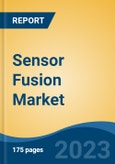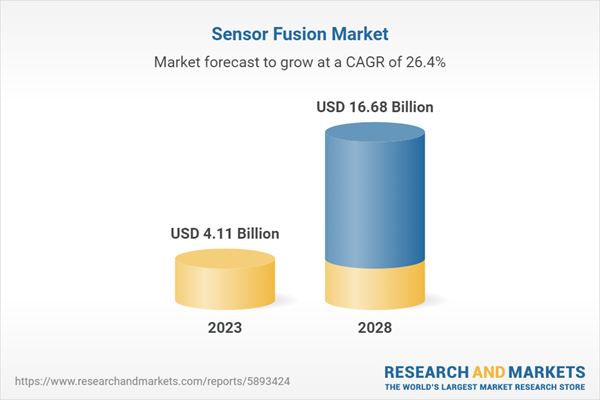Speak directly to the analyst to clarify any post sales queries you may have.
10% Free customizationThis report comes with 10% free customization, enabling you to add data that meets your specific business needs.
The growing trend towards self-driving or automated vehicles is one of the main drivers for the deployment of sensor fusion, offering advanced driver assistance (ADAS) and automated driving functions. In addition, road safety authorities around the world are taking various measures to reduce the number of road fatalities, which is contributing to the growth of the market. In navigation applications, sensor fusion combines global positioning systems (GPS) with phone data such as compass, gyroscope, and accelerometer, leading to an increase in demand for mobile mapping technology and positively impacting the growth of the industry. The growing trend of self-driving or automated cars is one of the major factors driving the use of sensor fusion and it provides advanced driver assistance (ADAS) features and automatic driving functions. Furthermore, road safety authorities around the world are implementing a variety of measures to reduce fatal road accidents, which is fueling the market growth.
Furthermore, the increasing use of Internet of Things (IoT) devices in smart water meters and internal temperature monitoring systems is increasing the global demand for sensor fusion. Sensor fusion technology is gaining popularity in wearable fitness equipment as health and fitness has become more of a focus. In addition, industry participants are working on software solutions to improve user experience in fast and intuitive games. This software can also be applied to industrial control, oil exploration, and climate monitoring, which helps to develop the market.
Advanced Driver Assistance Systems (ADAS) will Drive Global Sensor Fusion Market
ADAS is a group of functions that can help drivers avoid accidents. This includes, features such as automatic emergency braking, lane departure warning, and adaptive cruise control. Sensor fusion is used in many ADAS functions to combine data from multiple sensors to create a single, accurate view of the vehicle's surroundings. This information is then used by the vehicle's computer to control speed, steering, and braking.ADAS systems rely on sensor fusion technology to combine data from multiple sensors such as cameras, radar, and lidar to provide a more accurate and comprehensive view of the vehicle's surroundings. This technology is essential for enabling features such as lane departure warnings, adaptive cruise control, and automatic emergency braking, which are becoming increasingly common in modern vehicles.
Sensor fusion technology is also being used in other industries such as healthcare, aerospace, and defense. However, the automotive sector is expected to become the largest market for sensor fusion technology due to the increasing demand for ADAS and self-driving cars. The report suggests that the main challenges hindering progress in sensor fusion systems are the lack of consistency and the difficulty in integrating different sensors and algorithms. Sensor fusion technology is required to enable ADAS capabilities, and the market is expected to witness significant growth in the coming years. While there are challenges to overcome, the industry can overcome these challenges and continue to grow.
Increasing Use of Image Sensors in Smart Devices Drives Market Growth
The increasing use of image sensors in smart devices is driving the growth of the image sensor market. An image sensor is a semiconductor device that converts light into an electrical signal, which is then processed to create a digital image. Growing demand for next-generation smartphones with advanced features and modern integrated sensors is driving the growth of the synthetic sensor market. Various smart device manufacturers are increasing the demand for image sensors. Most digital cameras today use a standard configuration: a pixel array that sits above the 2D array of Bayer's RGB color filters. Each pixel contains a photodetector that absorbs filtered light to produce one of the primary colors. In addition, image sensors are becoming the backbone of new vehicles, innovative medical devices, driver assistance systems, automated manufacturing technologies, innovative building technologies, and systems of electricity. In addition, sensors are becoming more reliable, more specific, more accurate, often more innovative, easier to communicate, and more affordable, which makes them increasingly popular for Smart infrastructure development. As demand for cameras, camcorders, multimedia phones, and security cameras increases, image sensors are growing rapidly. The key player has invested heavily in image sensors; Sony leads in image sensors with a market share of more than 45%.Thus, the increasing use of image sensors in smart devices is driving the growth of the image sensor market. The demand for smartphones with high-quality cameras, the growing demand for advanced medical imaging solutions, the growing demand for ADAS capabilities in the automotive industry, the growing demand for robots in various industries, and the growing demand for high-quality images and videos in consumer electronics are just a few factors which are driving the global sensors fusion market.
Increasing Technological Advancements
Sensor combination is becoming more and more popular as technology advances, as it helps to create more precise sensing mechanisms to improve advanced system performance or repair modern applications. Sensor consolidation technology, also known as multi-sensory data fusion or progressive sensor data fusion, is a sub-discipline of data consolidation. This combination of sensor data is used in many scientific research facilities, current camera systems, and primary image processing is also used in self-driving vehicles. Recent technological advancements have also made it possible to generate or collect large amounts of valuable data from a variety of sources in various real-world applications. For example, sensor data can be easily generated and collected in many Internets of Things (IoT) applications, such as smart homes, smart grids, smart retail, smart cars, and smart cities. In addition, Industry 4.0 has encouraged OEMs to incorporate IoT into their operations. According to Maryville University, by 2025, more than 180 trillion gigabytes of data will be generated annually worldwide. IoT-enabled industries (IIoT) are expected to generate large amounts of data.Increasing technological advancements are expected to drive the global Sensor Fusion Market. Growing demand for consumer electronics, increasing adoption of 5G technology, increasing demand for system integration services, and advancements in AI are some of the factors driving the growth of the Sensor Fusion Market.
Market Segmentation
Based on type, the market is segmented into radar sensors, inertial measuring unit sensor (IMU), image sensor, and others. Based on technology, the market is segmented into MMES and non-MEMS. Based on end-user, the market is segmented into automotive, healthcare, consumer electronics, military & defense, and industrial. The market analysis also studies the regional segmentation to devise regional market segmentation, divided among North America, Europe, Asia-Pacific, South America, and Middle East & Africa.Company Profiles
Robert Bosch GmbH, Continental AG, NXP Semiconductors N.V, STMicroelectronics, ZF Friedrichshafen AG, Infineon Technologies, Allegro Microsystems, Denso Corporation, Sensata Technologies, Inc, and Elmos Semiconductor Se., are among the major players that are driving the growth of the global Sensor Fusion Market.Report Scope:
In this report, the global Sensor Fusion Market has been segmented into the following categories, in addition to the industry trends which have also been detailed below:Sensor Fusion Market, By Type:
- Radar Sensors
- Inertial Measuring Unit Sensor (IMU)
- Image Sensor
- Others
Sensor Fusion Market, By Technology:
- MMES
- Non-MEMS
Sensor Fusion Market, By End-User:
- Automotive
- Healthcare
- Consumer Electronics
- Military & Defense
- Industrial
Sensor Fusion Market, By Region:
- Asia-Pacific
- China
- Japan
- India
- Australia
- South Korea
- North America
- United States
- Canada
- Mexico
- Europe
- United Kingdom
- Germany
- France
- Spain
- Italy
- Middle East & Africa
- Israel
- Turkey
- Saudi Arabia
- UAE
- South America
- Brazil
- Argentina
- Colombia
Competitive Landscape
Company Profiles: Detailed analysis of the major companies present in the global Sensor Fusion Market.Available Customizations:
With the given market data, the publisher offers customizations according to a company’s specific needs.This product will be delivered within 1-3 business days.
Table of Contents
Companies Mentioned
- Robert Bosch GmbH
- Continental AG
- NXP Semiconductors N.V
- STMicroelectronics
- ZF Friedrichshafen AG
- Infineon Technologies
- Allegro Microsystems
- Denso Corporation
- Sensata Technologies, Inc
- Elmos Semiconductor Se.
Table Information
| Report Attribute | Details |
|---|---|
| No. of Pages | 175 |
| Published | October 2023 |
| Forecast Period | 2023 - 2028 |
| Estimated Market Value ( USD | $ 4.11 Billion |
| Forecasted Market Value ( USD | $ 16.68 Billion |
| Compound Annual Growth Rate | 26.3% |
| Regions Covered | Global |
| No. of Companies Mentioned | 10 |









